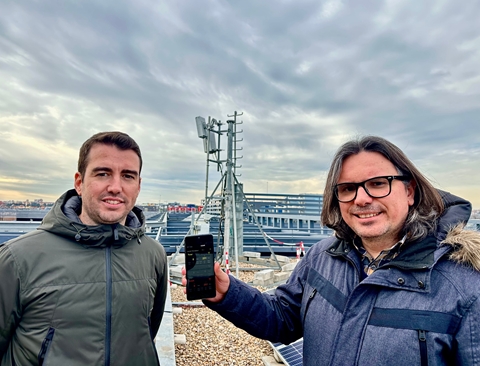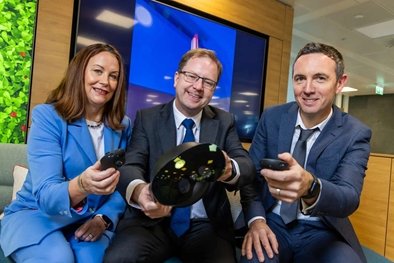Vodafone, Qualcomm, and Xiaomi in first European test of enhanced 5G uplink technology
Vodafone, Xiaomi, and Qualcomm Technologies Inc have successfully tested a new 5G technology that will pave the way for customers to get faster upload speeds and wider coverage with the arrival of new smartphones and devices expected during 2024.
In the first European technical test of this advanced 5G uplink technology, Vodafone, Qualcomm, and Xiaomi achieved peak upload speeds of up to 273 megabits-per-second (Mbps). Most of today’s smartphones and home broadband services are capable of an average upload speed of 100 Mbps. The enhanced 5G technology raises upload speeds closer to download levels whilst also extending coverage and increasing capacity.
The test combined the power of Vodafone’s new 5G Standalone (5G SA) networks in both Germany and Spain with the latest silicon technology from Qualcomm (The Snapdragon® 8 Gen 3 Mobile Platform) and the next Xiaomi flagship smartphone. Better uplink capabilities will enable customers to upload their photos, videos and files to social media sites and the cloud at almost double the speed possible today when next generation devices arrive later this year. This is important to meet the growing demand for cloud storage, video streaming, augmented and virtual reality applications and multi-player gaming.
Alberto Ripepi, Chief Network Officer of Vodafone said: “We want our customers to be among the first anywhere in the world to benefit from this new 5G feature when it becomes available. That’s why we are working with key partners to lead the industry in pulling together and testing the necessary network, silicon chips and devices to turn it into a reality, all while driving a stronger vendor and developer ecosystem.”
This technological breakthrough is made possible using the advanced capabilities of 5G SA. Specifically, the ability to enhance the uplink performance using a technique called Uplink Carrier Aggregation with Tx Switching which combines multiple transmission channels supported by the smartphone and the mobile antenna. Whereas most existing 5G services offered by telecoms companies rely partly on 4G technology, known as 5G non-standalone, Vodafone is pioneering the rollout of 5G SA. The company has launched it commercially in Germany (the first in the EU) and the UK, while also running pilots in other markets, and will progressively update sites to support Uplink Carrier Aggregation with Tx Switching as new devices become available.
Enrico Salvatori, Senior Vice President and President, Qualcomm Europe/MEA of Qualcomm Europe, Inc., said: “We are proud of our continued collaboration with Vodafone and Xiaomi to achieve another 5G milestone. The evolution of 5G towards 5G Standalone, the ultimate realisation of 5G technologies is a crucial step for enabling the full promise of 5G with 5G Advanced.”
“The successful pilot test of UL Tx switching highlights the added value that maximises resource utilisation with respect to user equipment’s capability and further enhances the uplink performance,” added Andi Zhang, Deputy General Manager of Product & Technology at Xiaomi. “We are committed to working with key partners in innovating in 5G and access technologies to enhance the customer experience and stay ahead.”
Note to Editors About the test in Germany and Spain
Today’s smartphones either have one or two channels dedicated to uplink, with each one offering approximately 100Mbps depending on where the user is (indoor or crowded areas tends to decrease capacity). Using Uplink Carrier Aggregation with Tx Switching, together with a commercial device, Vodafone and its technology vendors have been able to more optimised ways of transmitting information. This boosted speed by 35% to 54% depending on the distance between the smartphone and mobile site.
The successful tests took place in the Spanish city of Ciudad Real using Vodafone’s live, multi-vendor testing 5G network named ‘CREATE’ (Ciudad Real España Advanced Testing Environment) and Vodafone’s commercial 5G SA network in Hannover, Germany. The uplink boost is the latest 5G innovation from Vodafone, which also includes successful tests of 6GHz spectrum for boosting capacity in the future, as well as new software ideally suited to low powered devices like smart watches, credit card readers and portable routers, which doesn’t drain battery life.
About Vodafone
Vodafone is the largest pan-European and African telecoms company. Our purpose is to connect for a better future by using technology to improve lives, digitalise critical sectors and enable inclusive and sustainable digital societies.
We provide mobile and fixed services to over 300 million customers in 17 countries, partner with mobile networks in 46 more and are also a world leader in the Internet of Things (IoT), connecting over 167 million devices and platforms. With Vodacom Financial Services and M-Pesa, the largest financial technology platform in Africa, we serve more than 71 million people across seven countries.
We are committed to reducing our environmental impact to reach net zero emissions by 2040, while helping our customers reduce their own carbon emissions by 350 million tonnes by 2030. We are driving action to reduce device waste and achieve our target to reuse, resell or recycle 100% of our network waste by 2025.
For more information, please visit www.vodafone.com, follow us on Twitter at @VodafoneGroup or connect with us on LinkedIn at www.linkedin.com/company/vodafone.
For more information, please contact:
Investor Relations
Investors.vodafone.com
[email protected]
Media Relations
Vodafone.com/media/contact
[email protected]



























